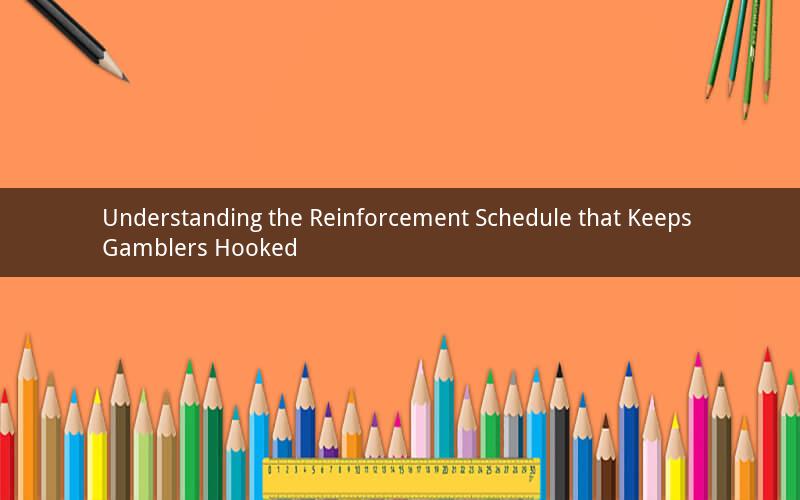
In the realm of gambling, the allure of the thrill and the promise of potential winnings can be irresistible. However, behind every successful gambler lies a psychological mechanism that keeps them engaged and often leads to excessive gambling behavior. This mechanism is known as the reinforcement schedule, and understanding it is crucial for both gamblers and those who aim to help them. In this article, we will explore the reinforcement schedule that keeps a gambler gambling and delve into the underlying factors that drive this behavior.
The Variable Ratio Schedule: The Ultimate Gamblers' Friend
Among various reinforcement schedules, the variable ratio schedule stands out as the most potent factor that keeps gamblers hooked. Unlike fixed ratio schedules, where a reward is given after a specific number of responses, the variable ratio schedule provides a reward after an unpredictable number of responses. This unpredictability creates a sense of tension and anticipation, making the behavior more engaging and addictive.
Imagine a slot machine that rewards a player after an average of 20 pulls, but the actual number of pulls before a win can vary significantly. This variability keeps the gambler on their toes, as they never know when the next winning combination will appear. This unpredictability is what makes the variable ratio schedule so effective in maintaining gambling behavior.
The Psychological Appeal of the Variable Ratio Schedule
The variable ratio schedule triggers a powerful psychological response in gamblers, primarily due to the release of dopamine in the brain. Dopamine is a neurotransmitter associated with pleasure and reward, and its release during the anticipation of a reward can be incredibly addictive.
When a gambler wins, the brain experiences a surge of dopamine, which reinforces the behavior and makes it more likely to occur again. However, when the gambler loses, the brain still releases dopamine, albeit at a lower level, as it anticipates the next winning moment. This continuous release of dopamine keeps the gambler engaged, as they strive to replicate the pleasurable experience of winning.
The Role of Probability and Expectation
Another crucial factor in maintaining gambling behavior is the perception of probability and expectation. Gamblers often believe that they can predict the outcome of a game based on their past experiences or intuition. This belief, known as the "gambler's fallacy," leads them to continue playing, despite the fact that each game is an independent event with the same probability of winning.
Moreover, gamblers tend to focus on the positive outcomes while ignoring the negative ones. This selective memory reinforces the belief that they can achieve success in the future, making them more likely to continue gambling.
The Impact of Social and Environmental Factors
While the variable ratio schedule and psychological factors play a significant role in maintaining gambling behavior, social and environmental factors cannot be overlooked. The presence of others who are also gambling can create a sense of camaraderie and encourage gamblers to continue playing. Additionally, the availability of gambling opportunities, such as casinos or online platforms, can make it easier for gamblers to access and engage in their behavior.
5 Questions and Answers about the Reinforcement Schedule that Keeps Gamblers Gambling
1. Question: What is the difference between a fixed ratio schedule and a variable ratio schedule?
Answer: A fixed ratio schedule provides a reward after a specific number of responses, while a variable ratio schedule provides a reward after an unpredictable number of responses. The unpredictability of the variable ratio schedule makes the behavior more engaging and addictive.
2. Question: How does the variable ratio schedule affect the brain's dopamine levels?
Answer: The variable ratio schedule triggers the release of dopamine in the brain, which is associated with pleasure and reward. This release reinforces the behavior and makes it more likely to occur again.
3. Question: What is the "gambler's fallacy," and how does it affect gambling behavior?
Answer: The gambler's fallacy is the belief that a random event is more likely to occur after a string of outcomes that seem to contradict the odds. This belief leads gamblers to continue playing, despite the fact that each game is an independent event with the same probability of winning.
4. Question: How do social and environmental factors contribute to gambling behavior?
Answer: Social factors, such as the presence of others who are also gambling, can create a sense of camaraderie and encourage gamblers to continue playing. Environmental factors, such as the availability of gambling opportunities, can make it easier for gamblers to access and engage in their behavior.
5. Question: Can the reinforcement schedule be used to treat gambling addiction?
Answer: While the reinforcement schedule is a significant factor in maintaining gambling behavior, it is not a standalone treatment for gambling addiction. A comprehensive approach that includes therapy, support groups, and lifestyle changes is often necessary to address the underlying psychological and social factors contributing to addiction.
In conclusion, the variable ratio schedule is a powerful psychological mechanism that keeps gamblers engaged and often leads to excessive gambling behavior. Understanding the factors that drive this behavior can help both gamblers and those who aim to help them develop effective strategies for prevention and treatment.